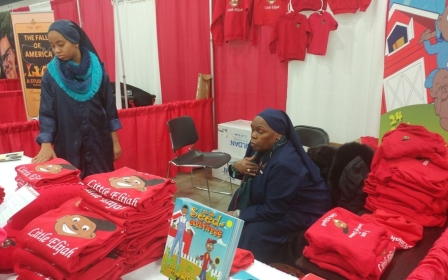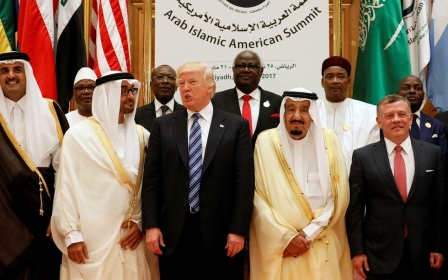From 9/11 to hate groups: The economic marginalisation of the West’s Muslims

Since 9/11, the objective of both violent Islamist militants and racist, anti-Muslim bigots has been to make life for Muslims living in the West as uncomfortable as humanly possible.
For the past decade and more, a constellation of events have converged to not only portray 1.6 billion Muslims as a monolithic cultural, social, and political entity, but also one that is synonymous with the nihilist, psychopathic violence of extremist groups such as the self-proclaimed Islamic State (IS) group.
From cable news to right wing blogs, from presidential campaigns to naked pro-Israel propaganda, Muslims living in the West have been depicted as a threat to Western democratic values and as the dangerous other.
The normalisation of fear and othering of Muslims has resulted in a myriad of negative impacts on Muslim communities, from draconian counterterrorism policies that put newly created legal frameworks around otherwise unlawful and unconstitutional practices of surveillance, profiling, detention, torture, and harassment, to public discourse that subtly encourages violence in the streets against Muslims and anyone who could be perceived as Muslim.
The parabolic rise of hate crimes against Muslims in Europe, the United States, and elsewhere has been well documented. For instance, the UK has not only experienced a 40 percent year-on-year increase in hate crimes, but also experienced a more than 500 percent increase in hate crimes against Muslims in the week following the IS-motivated London Bridge attack. Meanwhile anti-Muslim hate crimes in the US doubled in the first half of 2017 compared to the first half of the previous year.
Whereas both hate crimes against Muslims and controversial self-defeating counterterrorism measures have received limited media attention, what is less known is the cascading effects these circumstances have inflicted upon already downtrodden Muslim communities in the West.
A new report published by the UK government now sheds light on the socioeconomic impacts of Islamophobia in British society. Key findings include:
- Muslims experience the greatest economic disadvantages of any group in UK society.
- Muslims are more likely than non-Muslims to experience neighbourhood deprivation, housing, educational and health disadvantage, and unemployment.
- There is a "broken social mobility promise" for young Muslims where educational success does not translate into good labour market outcomes.
British Muslims live in the poorest neighborhoods, earn the lowest incomes, have less access to higher education, and experience disproportionate levels of discrimination. The authors note that taken together, “these contributory factors have profound implications for social mobility”. They conclude by asserting, “Muslims are excluded, discriminated against, or failed, at all stages of their transition from education to employment (or underemployment).”
Likewise, a 2016 report published by the House of Commons Women and Equalities Committee found social mobility disadvantages for British Muslims to be a result of a combination of, “discrimination and Islamophobia, stereotyping, pressure from traditional families, a lack of tailored advice around higher education choices, and insufficient role models across education and employment.”
When young British Muslims are asked to describe their reality, they say they feel they have to work “ten times harder” than their non-Muslim peers due to anti-Muslim discrimination, and that “Islamophobia, discrimination and/or racism is very present and pervasive, experienced in both direct and indirect forms and is experienced from schools through to work.”
In school, young British Muslims feel that “teachers have either stereotypical or overly low expectations of young Muslims,” and in the workplace, they feel “misconceptions and stereotypical assumptions about Islam or assumptions made about gender expectations can make it difficult for Muslims to integrate in the workplace.”
Significantly, these misconceptions and stereotypical assumptions concerning Muslims do not exist by happenstance, but rather as a result of a “series of interconnected political events, initiatives, shifting public sentiment, and targeted rhetoric,” according to a newly released report by the Haas Institute, titled, “Legalizing Othering: the United States of Islamophobia.”
Tracing the origins of today’s anti-Muslim hysteria to a 1990 article published by The Atlantic Monthly and written by Bernard Lewis, which erroneously portrayed Islam to be antithetical to Western values, the authors observe that this “clash of civilizations” thesis has been seized upon by academics such as Samuel Huntington, media pundits such as Bill Maher, and politicians such as Donald Trump.
Essentially, the attacks of September 9/11 served to expand this “us versus them” dichotomy in public discourse, forever depicting Muslims and Arabs as “the chief bogeys of our most paranoid fantasies”.
According to this report, Islamophobia percolated on the fringes of Western society in the first decade that followed 9/11, but became injected into the mainstream when hyper-anti-Muslim extremists Pamela Geller and Robert Spencer orchestrated protests against the supposed “Mosque at Ground Zero” in 2010. The manufactured outrage these protests generated across right-wing media outlets served to elevate a cadre of typically pro-Israel funded Islamophobic opportunists, thus normalising a culture of anti-Muslim suspicion and hatred.
At the same time, anti-Islam hate groups and organisations emerged to capitalise on the public’s growing antipathy towards Muslims, such as ACT4America, led by the notorious Islamophobe Brigitte Gabriel, and American Laws for American Courts (ALAC), led by David Yerushalmi, an activist within the Israeli settlement movement who has been described as the “man behind the anti-Sharia movement”.
Together these Muslim-hating individuals and groups have coalesced to not only infuse narratives that portray Muslims as terrorists in waiting, but also sponsor legislation that alienates Muslims as the dangerous other, helping introduce hundreds of anti-Sharia and anti-burqa laws throughout a number of Western countries.
Ultimately, these are the forces that have converged to pave the way for the further socio-economic-political marginalisation of Muslims in the West, which not only undermines social cohesiveness, but also plays into the hands of extremist groups that telegraph the notion Muslims are unwanted in the West.
- CJ Werleman is the author of Crucifying America (2013), God Hates You. Hate Him Back (2009), and Koran Curious (2011), and he is the host of Foreign Object. Follow him on twitter: @cjwerleman
The views expressed in this article belong to the author and do not necessarily reflect the editorial policy of Middle East Eye.
Photo: A constellation of events have converged to not only portray 1.6 billion Muslims as monolithic cultural, social, and political entity, but also one that is synonymous with the nihilist, psychopathic violence of extremist groups (AFP).
This article is available in French on Middle East Eye French edition.
New MEE newsletter: Jerusalem Dispatch
Sign up to get the latest insights and analysis on Israel-Palestine, alongside Turkey Unpacked and other MEE newsletters
Middle East Eye delivers independent and unrivalled coverage and analysis of the Middle East, North Africa and beyond. To learn more about republishing this content and the associated fees, please fill out this form. More about MEE can be found here.





